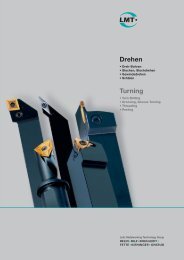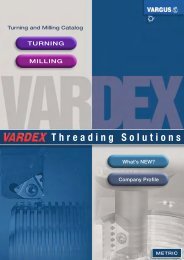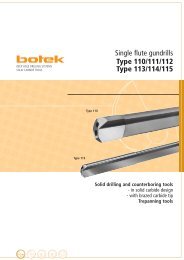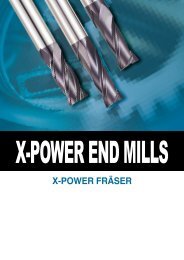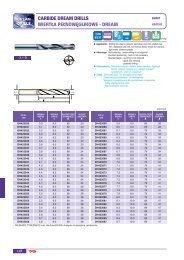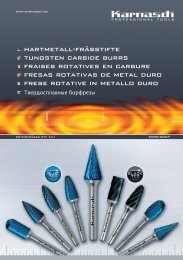Gear Cutting Tools
Hobs - Torion
Hobs - Torion
- No tags were found...
You also want an ePaper? Increase the reach of your titles
YUMPU automatically turns print PDFs into web optimized ePapers that Google loves.
The enormous increases in tool life<br />
over that of uncoated tools can be<br />
attributed to the physical friction<br />
and the chemical characteristics,<br />
in addition to the high hardness.<br />
The low chemical affinity of the TiN<br />
to the hot steel chip leads to lower<br />
friction and in turn to less frictional<br />
heat, thereby reducing the wear.<br />
The coating acts as a barrier which<br />
protects the underlying substrate<br />
against wear.<br />
Toll life travel per cutter tooth (m)<br />
10<br />
8<br />
6<br />
4<br />
2<br />
0<br />
TiN TiN / reground Uncoated<br />
The higher cutting and feed<br />
speeds possible with coated tools<br />
are particularly advantageous for<br />
the user. A chief factor is not only<br />
the longer tool life, but also the reduction<br />
in production times. Coated<br />
hobs thus recoup their coating<br />
costs within a very short space of<br />
time.<br />
Workpiece: Sun wheel<br />
Material: 17CrNiMo6<br />
Tool:<br />
HSS hob<br />
Dimensions: d 90 x 80 mm<br />
Module: 3 mm<br />
Number of starts: 1<br />
Number of gashes: 12<br />
Quality grade: AA<br />
<strong>Cutting</strong> data<br />
<strong>Cutting</strong> depth:<br />
<strong>Cutting</strong> speed:<br />
Axial feed:<br />
Tip chip thickness:<br />
Shift length:<br />
6,808 mm<br />
65 m / min<br />
3 mm / WU<br />
0,224 mm<br />
54,3 mm<br />
The tool life of an HSS hob used<br />
for the manufacture of a sun wheel<br />
was increased five-fold from 100<br />
to 502 finished wheels by the application<br />
of a TiN coating. Following<br />
regrinding, the tool was not recoated,<br />
and was therefore coated<br />
only on the flank, and not on the<br />
cutting face. It nevertheless attained<br />
an average tool life of 251<br />
finished wheels in this condition.<br />
Over a total of 22 regrinding cycles,<br />
a total of 2300 wheels were<br />
manufactured with the uncoated<br />
hob and 6024 with the coated hob,<br />
i.e. 2.6 times the number. The relatively<br />
low additional cost of the TiN<br />
coating was therefore recouped<br />
with ease.<br />
Workpiece<br />
Coating<br />
Higher hardness<br />
+ Lower friction<br />
+ Reduced diffusion<br />
= Lower wear<br />
Wedge<br />
Chip<br />
Coating<br />
Re-coating following regrinding (of<br />
the cutting face) of a worn HSS<br />
tool is also economically viable.<br />
Use of the ion plating process for<br />
TiN coating presents no problems.<br />
The tool can be re-coated several<br />
times; alternatively, the coating<br />
can also be removed chemically in<br />
a bath.<br />
The combination of TiN on carbide<br />
is somewhat more complicated,<br />
although repeated coating is still<br />
possible. Removal of the coating<br />
from carbide in the bath is however<br />
difficult, owing to the chemical<br />
affinity of the carbides and the TiN<br />
coating.<br />
Re-coating of the grey-violet TiCN<br />
presents greater problems, since<br />
TiCN has a multi-layer structure.<br />
Structures of this kind cannot simply<br />
be "stacked" one upon the<br />
other without difficulty. Removal of<br />
the coating from HSS by immersion<br />
in a bath is possible, but still<br />
more complex than with TiN. On<br />
carbide, the problems described<br />
above are also encountered.<br />
The gold TiCN Plus is an interesting<br />
coating type. Essentially, this is<br />
a TiCN multi-layer coating with<br />
high resistance to abrasion. A pure<br />
TiN surface coat is however deposited<br />
at the end of the coating<br />
process. As a result, the friction<br />
behaviour of the chip on the tool is<br />
influenced chiefly by the TiN- surface<br />
layer, the abrasion resistance<br />
by the underlying TiCN. TiCN Plus<br />
is more conducive to re-coating<br />
than TiCN.<br />
152



